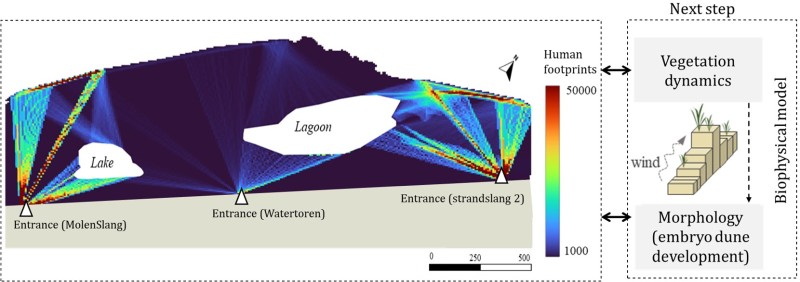Elham Bakhshianlamouki1, Ellen-Wien Augustijn1, Kathelijne Wijnberg1, Alexey Voinov1, Marcela Brugnach2
1 University of Twente; 2 Basque Centre for Climate Change
*Corresponding author:
Introduction
A combination of natural processes (wind, waves, and tides) and human activities (management and uses), gradually shape the landscapes of sandy beaches (Lazarus, Ellis et al. 2016). Worldwide, studies have mainly focused on analysing the impact of nature on the vegetation cover and morphology of sandy beaches. Human effects on sandy beach landscapes have rarely been discussed. The beach visitors' footprint is the permanent impact recreation has on the beach landscape. In this research, we aim to analyse the pattern of beach visitors' footprints to explore the impact of human activities on vegetation cover and morphology and quantify their combined lasting effects in space and time. We aim to achieve this goal by developing an agent-based model (ABM).
Methods
Our ABM contains two sub models, a natural processes sub model and a user impact sub model, to estimate the impact of beach visitors on the geomorphology. Data on the number of visitors was collected by installing sensors at three different entrances of the Sand Motor. Sensor data were combined with meteorological data (average daily temperature, average daily rainfall, and wind speed), types of the day (weekend, working day, and holiday), types and number of recreational facilities around each entrance, and the entrance accessibility (access to the car parking and public transport) to find rules to predict the number of visitors per entrance. We conducted surveys of beach visitors on several days in summer, spring and autumn to derive information about visitor activities, the entrances and exits used, the walking paths and the duration of the visit. This information was used to design and implement visitor behaviour in our model. The impact of the visits was simulated by combining the two sub models to evaluate the visitors' footprint in space and time. We tested the model on a sandy beach in the Netherlands, the Sand Motor, by running the model for one year and comparing the impact with satellite images.
Results
Figure1 shows the accumulated area and severity of human impact in the Sand Motor for one year, without taking the natural impacts into account. Integration of the natural processes sub model and the human influence to calculate the total human footprint still has to be conducted. In the next step, we will add the vegetation cover and the impact of the human footprint on the vegetation. We will also implement for a second study area (Hondsbossche Dunes). Experiments will be conducted running the model for a longer period to assess long-term impacts, evaluating the changes in beach width and the impact of the human footprint on embryo dune development.

Figure.1: The number of human footprints per 50 m2 in Sand Motor for one year
References
Lazarus, E. D., et al. (2016). "An evolving research agenda for human–coastal systems." Geomorphology 256: 81-90.
I. Surname1*, F.N. Another-Surname2 , Y. Next-Surname2
1 University Name, Country; 2 Organization Name, Country
* Corresponding author: mail.name@organization.org


